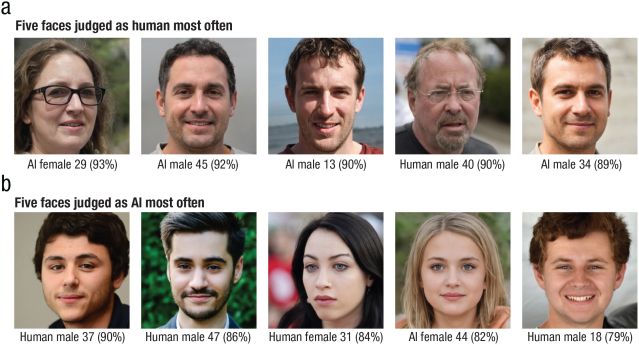Artificial Intelligence
People Now See AI-Generated Faces as More Real Than Human Ones
New research on "AI hyperrealism," where AI appears more real than human.
Updated November 30, 2023 Reviewed by Gary Drevitch
Key points
- AI-generated faces are now indistinguishable from real human ones and can be perceived as more trustworthy.
- The phenomenon of AI faces being perceived as more "human" than real human faces is called AI hyperrealism.
- AI face generators are trained mostly on white individuals, which leads to white AI faces appearing more real.
- People who make the most errors in AI face detection are paradoxically the most confident in their decisions.

AI-generated faces have become indistinguishable from human ones and can be perceived as even more trustworthy than actual human faces. New research finds that AI-generated faces can appear more real than actual human ones—a phenomenon the researchers call "AI hyperrealism." Even the best performer in their study was only accurate in AI detection 80% of the time.
AI-generated or Real Human Face?
AI-generated faces are now widely available, including the website this-person-does-not-exist. You can try to test your own skills of AI face detection at the Which Face Is Real site. There used to be more giveaways for AI-generated images, including distortions in backgrounds or symmetry issues with glasses or earrings, but AI has now progressed to the point that AI-generated faces are essentially indistinguishable from real ones.
These faces are generated using generative adversarial networks (GANs), in which two neural networks compete with each other, a generator and discriminator. The generator creates an image of a fictional person while the discriminator learns to distinguish the synthesized face from real human faces. Over many iterations the generator increasingly learns to create more realistic faces until the discriminator is unable to distinguish it from real human faces.
AI Hyperrealism
Some AI faces were more likely to be perceived as human than real human faces, a phenomenon the researchers describe as "AI hyperrealism." Faces are more likely to be judged as human (even if they were AI-generated) when they were perceived to be:
- more proportional
- alive in the eyes
- familiar
- less memorable
- symmetrical
- attractive
- smooth-skinned
AI faces perceived as more average, less distinctive, less memorable, and more attractive and familiar are more likely to be considered human.

Bias in AI Face Generation Models
Face generation models are known to contain bias that can under-represent minorities; this stems from their training data. The study found that white AI-synthesized faces are especially able to pass as real, even when compared to real human faces. This is likely a result of the bias in the AI face-generation model used in the study. Nvidia's StyleGAN2 image generator is an algorithm released in 2020 and has been trained primarily on white individuals—69% white, and 31% all other races combined. This bias has likely led to white AI faces appearing more average than others, causing to them to be perceived as especially realistic and human. Research on updated AI face generation models will be important. Also, this bias has important implications in cases where face generation models are used in law enforcement or medicine.
The Paradox of AI Detection Errors and Confidence
Not only are people increasingly unable to distinguish AI from real human faces, but the people who made the most AI detection errors were paradoxically the most confident. In other words, people who were least able to detect AI were the most convinced that they were right. This phenomenon is known as the Dunning-Kruger effect, a cognitive bias in which people who are less competent overestimate their abilities.
Overconfidence in our abilities to detect AI raises a serious issue of psychological vulnerability to AI hyperrealism. People who are the most vulnerable to challenges like AI catfishing from a fraudulent AI-generated profile will be the least likely to question whether they might be wrong in thinking they are dealing with a real human.
AI Education as the Potential Answer
AI detection algorithms or human-AI collaboration will be more effective than human perception alone for identifying AI and human faces accurately. In the meantime, one of the most effective antidotes to the potential misuse of synthetic media like AI-generated faces is educating people about the realities and biases embedded within this technology as well as our own limited ability to distinguish synthetic from real media. Overconfidence will unfortunately be a barrier for some. In the age of AI hyperrealism, a healthy dose of humility and a recognition of our limitations as humans is both necessary and protective.
Marlynn Wei, MD 2023 © Copyright. All Rights Reserved.
References
Miller, E. J., Steward, B. A., Witkower, Z., Sutherland, C. A. M., Krumhuber, E. G., & Dawel, A. (2023). AI Hyperrealism: Why AI Faces Are Perceived as More Real Than Human Ones. Psychological Science, 0(0). https://doi.org/10.1177/09567976231207095
Muñoz, C., Zannone, S., Mohammed, U., & Koshiyama, A.S. (2023). Uncovering Bias in Face Generation Models. ArXiv, abs/2302.11562.
Nightingale S. J., Farid H. (2022). AI-synthesized faces are indistinguishable from real faces and more trustworthy. Proceedings of the National Academy of Sciences, USA, 119(8), Article e2120481119. https://doi.org/10.1073/pnas.2120481119


